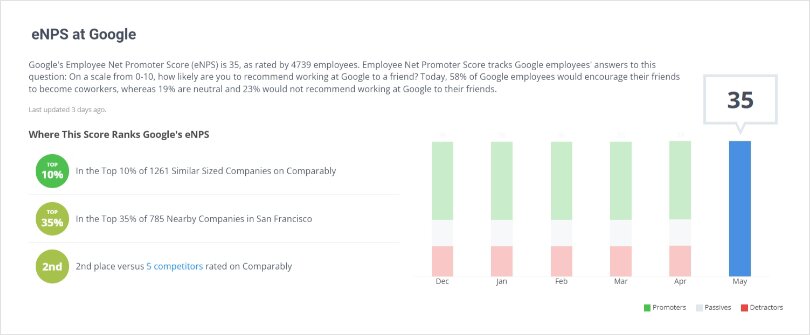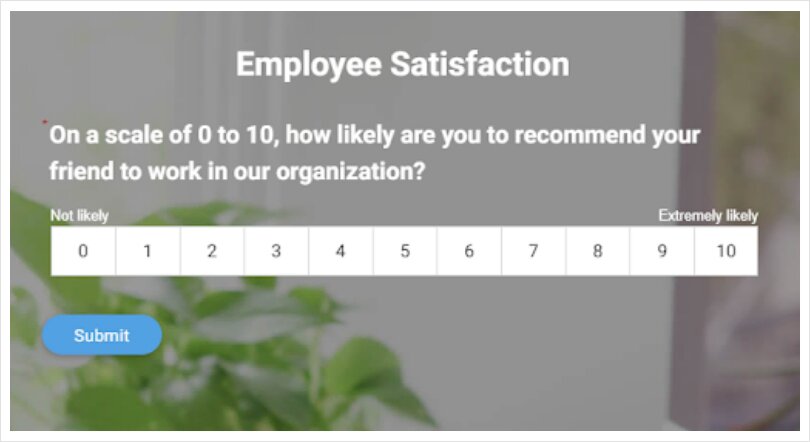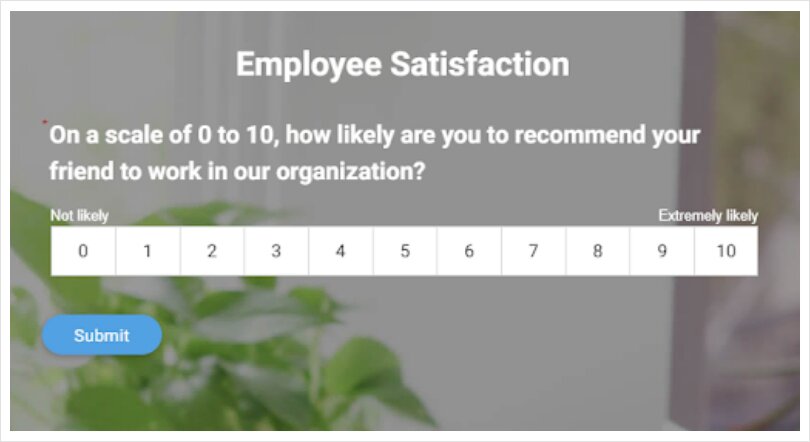
Let us quiz you: “What do you consider to be one of the pillars of a successful company?”
If your answer is ‘talented employees,’ we’re on the same page.
A reliable and dedicated workforce is critical to sustain a business and promote growth. And it all starts with a positive and growth-driven work environment. Otherwise, you’re basically pushing your people toward the next best opportunity.
After all, work-life balance and office environment are among the top factors affecting employees’ long-term commitment to the job.
But here’s a minor hiccup: How can you measure customer satisfaction and loyalty to create such a workforce?
Enters Employee Net Promoter Score (eNPS).
eNPS is a powerful metric that enables you to zoom in on employee experience and identify gaps and areas for improvement.
It helps to measure the impact of work environment and practices on engagement and satisfaction at individual and organizational levels.
So, let’s cover everything about this helpful metric end-to-end – from benefits to best practices and how to get the most out of eNPS in your business.
What Is Employee Net Promoter Score or e NPS?
The Employee Net Promoter Score (eNPS) is a satisfaction metric businesses use to monitor employee satisfaction and loyalty towards a company and its work environment.
The respondents are asked to rate their likelihood of recommending the company to others on a scale of 0 (not likely) to 10 (highly likely).

This question is generally followed by an open-ended question that explores the reasons behind the respondent’s rating, such as: ‘What is the reason for your answer?’
You can also add more questions to gather in-depth insights about employee experience.
The feedback can help businesses understand the quality of their work culture, office environment, and employees’ work conditions. This way, they can find room for improvement to boost workforce satisfaction, leading to high employee retention.
You can also use eNPS surveys at different stages to track the employee journey, such as, during employee onboarding, training, and performance appraisals.
Why Measure Employee NPS: Importance & Benefits
Here are a few points that clearly elaborate on the importance and benefits of tracking employee NPS for your business:
Gauge Overall Employee Loyalty
Like companies use the customer net promoter score to gauge customer loyalty, you can leverage the eNPS to measure employee loyalty, satisfaction, and engagement.
It allows businesses to understand what areas of the work ecosystem require the utmost attention to make it an ideal environment for boosting employee morale and productivity.
An Upgrade From Long-Form Surveys
The last thing employees look forward to is filling out lengthy surveys on top of their KRAs (key responsibility areas). A dissatisfied employee might not even bother to take the pain of filling out a tedious questionnaire. Add on top of it the phenomenon of ‘Survey fatigue.’
That’s where a feedback survey tool like ProProfs Survey Maker comes in handy with its short-form online eNPS surveys.
Employee Net Promoter Score survey only consists of one question and you can send it via a link on SMS, internal communication portals, and work emails. And because of its compact nature, it enjoys a high participation rate.
Watch: How to Create a Survey Using ProProfs Survey Maker
Reduce Employee Attrition
If you want to focus on the bigger picture, eNPS offers insights into employees’ experience with a company and their pain points. You can use these insights to improve the work environment and increase employee satisfaction and engagement.
Happy and engaged employees are more likely to stick with a company for a long time and may influence others to come on board.
Watch: 6 Quick Tips to Create Awesome Employee Engagement Surveys
Gives a Chance to Convert Negatives to Positives
By identifying detractors or unsatisfied employees, you can take appropriate steps to make things right. For example, you can conduct one-on-one sessions with these employees to closely understand their issues and manage the situation accordingly.
eNPS Is Cost-Effective
Measuring your workforce’s satisfaction levels through employee net promoter score is an economical option. It requires minimal time and budget commitments, as initiating the process takes just one email or survey.
The combination of these benefits enables you to conduct regular check-ins with your employees, allowing you to reduce employee attrition.
How to Calculate Employee Net Promoter Score?
Employee Net Promoter Score asks, “How likely are you to recommend this company as a place to work?”
Employees rate their answers on a scale of 0-10, which you can also follow up with more questions to get contextual and constructive feedback.
Based on their answer, you can categorize the respondents as:
- Promoters (9-10)
- Detractors (0-6)
- Passives (7-8)
You can follow this simple formula to calculate your employee net promoter score:

For example, let’s assume you surveyed 100 employees in your organization. Of these, 20 employees rated 0-6, 70 gave scores between 9-10, and 10 rated scores between 7-8.
Based on this data, the percentage of promoters, detractors, and passives will be:
% of detractors = 20/100 x 100 = 20%
% of promoters = 70/100 x 100 = 70%
% of passives = 10/100 x 100 = 10%
So the eNPS Score becomes (70 – 20) = 50
This 11-point scale corresponds to the traditional customer NPS and provides variance by identifying the following:
- Promoters as the most positive, motivated, and satisfied individuals
- Passives as neutral but not fully committed employees.
- Detractors as unhappy and disengaged employees.
8 Best Practices to Improve Your Employee Net Promoter Score
Simply calculating the eNPS score won’t help your business. So, it also makes sense to cover some best practices to make the most out of the exercise.
Make eNPS a Part of Your Retention Program
Think of NPS for employees as a gateway into opportunities to improve. Along with your survey surveys, you can also ask employees:
- Their opinions on what skills they’d like to get training for,
- What workshops can help them upskill,
- What else a company can offer to improve its experience.
Probing deeper into your eNPS insights can also help you understand why some employees are promoters and what makes other detractors or passives.
Be Transparent
Being open and transparent with your employees is important to improve your work environment. Loop them in your final decisions and how you plan to enhance their experience.
Keep the communication open and encourage them to share their thoughts and feedback about your recommendations.
Time Your eNPS Surveys
You must wonder, “How often should you conduct employee net promoter score surveys?” Well, there is no one-word answer.
You don’t want to overdo or underdo it. So, it’s best to track your eNPS regularly. You can aim to collect the scores every 3-4 months.
This way, you will have enough time to address the feedback and then re-run the survey to track the results of your efforts.
Make the Surveys Anonymous
To gather unbiased employee feedback, you can make your employee NPS surveys anonymous. Doing so will put your employees at ease since they won’t fear repercussions for their honest feedback and can freely share their feedback.
Follow-up on Your eNPS
As we mentioned above, adding a follow-up question to your eNPS surveys is an effective way to collect contextual employee feedback. It’ll allow you to understand why they gave you the score they gave.
The passives may not be a detractor yet, but they can become detractors or promoters depending on your corrective measures.
In the same way, detractors will help you understand where you’re lacking, and promoters will inform you about what you’re doing right.
Consistently Track Your eNPS
To consistently enhance your employee experience, you need to track your eNPS score. Deploying an eNPS survey after implementing positive changes can help you assess the effectiveness of those changes.
Using this feedback tool consistently is important to ensure you’re on track toward your goal.
For example, let’s say you’re a tech startup manager who recently implemented flexible work hours and remote work options for your team.
By deploying an eNPS survey a month after implementing these changes, you can get valuable feedback from your employees and determine if these changes have positively impacted their work-life balance and overall satisfaction.
Don’t Just Collect; Act on It
Like customer NPS, conducting employee net promoter score surveys will only be worthwhile if you act on the feedback and explore the reasons behind your scores.
So, utilize the contextual feedback from the eNPS surveys and follow-up questions to fix what needs fixing and strive towards an efficient and positive work environment.
Send Reminders
Since taking employee NPS survey is usually effortless, you can expect a relatively high participation rate. So you might not need to send reminders for the same.
Even so, if you need to gather more responses, you can gently remind your employees to complete the survey. This way, you can retarget people who might have forgotten to fill out the survey or didn’t want to in the first place. A brief email will suffice here.
Employee Net Promoter Score (eNPS) Benchmarks
Well, eNPS benchmarks are like fingerprints; each company has its own employee net promoter. It also varies from industry to industry. For example, Google’s eNPS is around 35, which for some industries might be average, but for its industry, it’s high.
So, instead of comparing your employee net promoter score with other companies, benchmark your eNPS on your previous score. This way, you can track your success with your score and how far you’ve improved.

Build a Loyal Workforce by Tracking Employee Net Promoter Score
The employee net promoter score (eNPS) is valuable for measuring employee satisfaction, loyalty, and engagement. You can use NPS for employees to identify areas for improvement and take action to boost employee engagement and loyalty.
Besides the ones we discussed, some additional effective strategies for improving eNPS include offering competitive compensation and benefits, fostering a positive work environment, and investing in employee development and training.
By prioritizing employee satisfaction and loyalty, you can build a team of motivated, loyal, high-performing employees committed to achieving your company’s goals.
But to take corrective actions, you’ll need a reliable tool to effectively collect and analyze the contextual feedback and track your eNPS. So, invest in a feature-rich, hassle-free eNPS tool that automates the process for you.
Frequently Asked Questions
What is a good eNPS?
A good eNPS score varies depending on factors such as industry and company size, but generally, a score between 10-30 is considered excellent. It’s important to compare your score to industry standards and track it over time to evaluate your progress.
Is eNPS the same as NPS?
Fundamentally, both gauge loyalty. The difference is that employee net promoter score (eNPS) gauges employee loyalty, whereas net promoter score (NPS) gauges customer loyalty.
FREE. All Features. FOREVER!
Try our Forever FREE account with all premium features!







